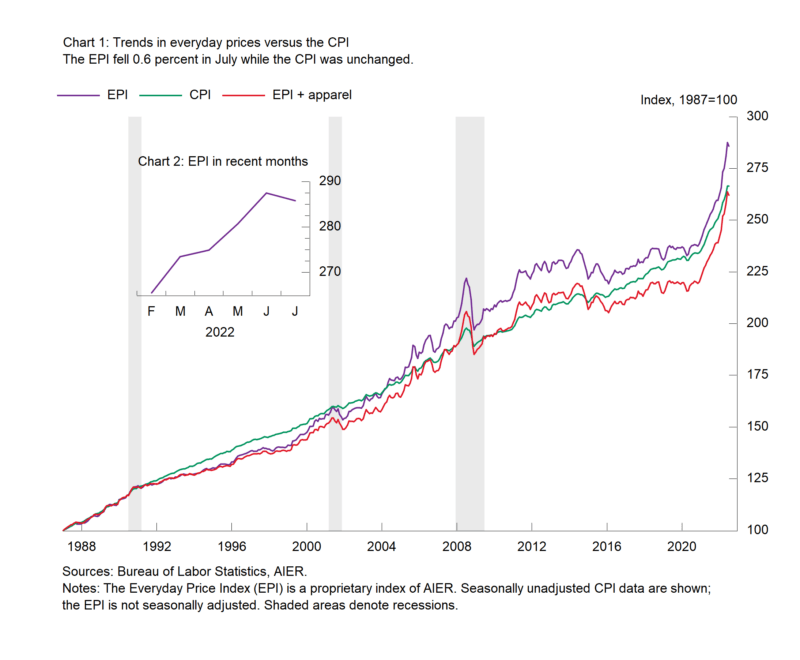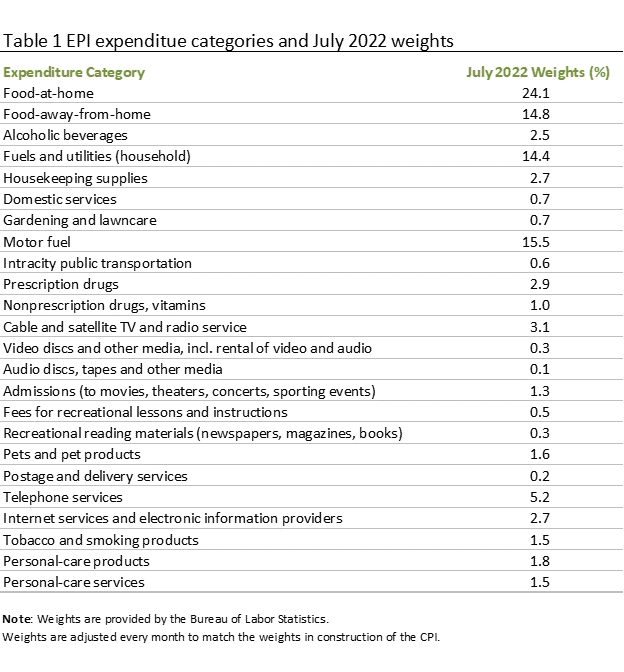AIER’s Everyday Price sank 0.6 percent in July after a 2.4 percent jump in June. The July EPI broke a string of 19 consecutive increases dating back to December 2020. From a year ago, the Everyday Price Index is up 13.0 percent, less than the 14.6 percent 12-month gain through June.
Motor fuel prices, which are often a significant driver of the monthly changes in the Everyday Price index because of the large weighting in the index and the volatility of the underlying commodity, led the decliners with a 7.6 percent price drop for the month (on a not-seasonally adjusted basis). Six other components showed price declines in July, including a 1.0 percent drop in recreational reading materials, a 0.9 percent decline in internet services, and a 0.6 percent fall in cable and satellite services. A total of seven categories showed declines in July, the highest number since March.
Price increases were led by admissions for events (up 2.1 percent). The two largest positive contributors in July were food at home (up 1.4 percent and contributing 35 basis points) and food away from home (up 0.7 percent for the month and adding 11 basis points). A total of 15 categories had price increases, also the lowest number since March.
The Everyday Price Index including apparel, a broader measure that includes clothing and shoes, also fell 0.6 percent in July. Over the past year, the Everyday Price Index including apparel is up 12.4 percent versus a 12-month gain of 13.9 percent for the period ending June.
Apparel prices fell 1.1 percent on a not-seasonally-adjusted basis in July. Apparel prices tend to be volatile on a month-to-month basis. From a year ago, apparel prices are up 5.1 percent.
The Consumer Price Index, which includes everyday purchases as well as infrequently purchased, big-ticket items and contractually fixed items, was unchanged on a not-seasonally-adjusted basis in July. Energy posted a 4.5 percent drop on a not-seasonally-adjusted basis while food had a 1.1 percent increase. Over the past year, the Consumer Price Index is up 8.5 percent, down from 9.1 percent for the 12-month period through June.
The Consumer Price Index excluding food and energy rose 0.3 percent for the month (not seasonally adjusted) while the 12-month change came in at 5.9 percent. The 12-month change in the core CPI was just 1.3 percent in February 2021 and 2.3 percent in January 2020, before the pandemic.
After seasonal adjustment, the CPI was unchanged in July while the core increased 0.3 percent for the month. Within the core, core goods prices were up 0.2 percent in July and 7.0 percent from a year ago. Significant increases for the month were seen in new vehicles (0.6 percent) and household furnishings (0.6 percent), while used cars and trucks posted a 0.4 percent drop.
Core services prices were up 0.4 percent for the month and 5.5 percent from a year ago. Among core services, gainers include health insurance (up 2.2 percent and 20.6 percent from a year ago), motor vehicle repair (1.1 percent and 8.1 percent from a year ago), motor vehicle insurance (up 1.3 percent for the month and 7.4 percent from a year ago), medical care (up 0.4 percent for the month and 5.1 percent from a year ago), and owners’ equivalent rent (which accounts for 23.5 percent of the CPI, rose 0.6 percent for the month and 5.8 percent from a year ago).
Among the major component indexes to decline in July were lodging away from home (-2.7 percent for July but still up 1.0 percent from a year ago) and transportation services (-0.5 percent for July but up 9.2 percent from a year ago). Within transportation services, airline fares fell 7.8 percent for the month but were up 27.7 percent from a year ago, and car and truck rentals fell 9.5 percent for the month and 11.9 percent from a year ago.
Price pressures for many goods and services in the economy remain elevated due to shortages of supplies and materials, logistical and supply chain issues, and labor shortages and turnover. However, there are some early signs that some of the pressures may be easing.
Still, sustained elevated price increases are likely distorting economic activity by influencing consumer and business decisions. Furthermore, price pressures have resulted in an intensifying Fed tightening cycle, raising the risk of a policy mistake. The fallout surrounding the Russian invasion of Ukraine continues to disrupt global supply chains. All of these are sustaining a high level of uncertainty for the economic outlook. Caution is warranted.
* This article was originally published here
PUBLISH WITH US!
The Washington Gazette works at our discretion with businesses, non-profits, and other organizations. We do not work with socialists, crony capitalists, or disinformation groups. Click the green button below to view our services!
HELP STOP THE SPREAD OF FAKE NEWS!
SHARE our articles and like our Facebook page and follow us on Twitter!






0 Comments